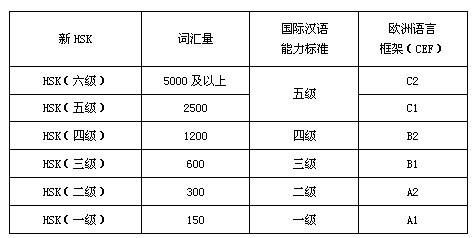The new HSK test was launched by Hanban in an effort to better serve Chinese language learners. The test is the result of coordinated efforts by domestic and foreign experts from different disciplines including Chinese language teaching, linguistics, psychology and educational measurement. The new exam combines the advantages of the original HSK while taking into consideration recent trends in Chinese language training by conducting surveys and making use of the latest findings in international language testing.
The new HSK is an international standardized exam that tests and rates Chinese language proficiency. It assesses non-native Chinese speakers’ abilities in using the Chinese language in their daily, academic and professional lives. HSK consists of six levels, namely the HSK (level I), HSK (level II), HSK (level III), HSK (level IV), HSK (level V), and HSK (level VI).
Details are as follows
The new HSK test was launched by Hanban in an effort to better serve Chinese language learners. The test is the result of coordinated efforts by domestic and foreign experts from different disciplines including Chinese language teaching, linguistics, psychology and educational measurement. The new exam combines the advantages of the original HSK while taking into consideration recent trends in Chinese language training by conducting surveys and making use of the latest findings in international language testing.
I. Test Structure
The new HSK is an international standardized exam that tests and rates Chinese language proficiency. It assesses non-native Chinese speakers’ abilities in using the Chinese language in their daily, academic and professional lives. HSK consists of six levels, namely the HSK (level I), HSK (level II), HSK (level III), HSK (level IV), HSK (level V), and HSK (level VI).
II. Test Levels
The levels of the new HSK correspond to the levels of the Chinese Language Proficiency Scales for Speakers of Other Languages (CLPS) and the Common European Framework of Reference for Languages (CEF) as follows:

| New HSK |
Vocabulary |
CLPS |
CEF |
| HSK (Level VI) |
Over 5,000 |
Level V |
C2 |
| HSK (Level V) |
2500 |
C1 |
| HSK (Level IV) |
1200 |
Level IV |
B2 |
| HSK (Level III) |
600 |
Level III |
B1 |
| HSK (Level II) |
300 |
Level II |
A2 |
| HSK (Level I) |
150 |
Level I |
A1 |
Test takers who are able to pass the HSK (Level I) can understand and use very simple Chinese words and phrases, meet basic needs for communication and possess the ability to further their Chinese language studies.
Test takers who are able to pass the HSK (Level II) have an excellent grasp of basic Chinese and can communicate in simple and routine tasks requiring a simple and direct exchange of information on familiar and routine matters.
Test takers who are able to pass the HSK (Level III) can communicate in Chinese at a basic level in their daily, academic and professional lives. They can manage most communication in Chinese when travelling in China.
Test takers who are able to pass the HSK (Level IV) can converse in Chinese on a wide range of topics and are able to communicate fluently with native Chinese speakers.
Test takers who are able to pass the HSK (Level V) can read Chinese newspapers and magazines, enjoy Chinese films and plays, and give a full-length speech in Chinese.
Test takers who are able to pass the HSK (Level VI) can easily comprehend written and spoken information in Chinese and can effectively express themselves in Chinese, both orally and on paper.
III. Test Principles
The new HSK follows the principle of “test-teaching correlation”, bases the design of the test on the current trends in international Chinese language training, and is closely related to textbooks. The purpose of the test is to “promote training through testing” and “promote learning through testing”.
The new HSK emphasizes the objectivity and accuracy of the evaluation and stresses the learners’ actual Chinese language abilities.
The new HSK sets clear test objectives to allow the test takers to be able to improve their Chinese language abilities in a systematic and efficient way.
IV. Testing Purposes
The new HSK retains the former HSK’s orientation as a general (or universal) Chinese language abilities test for adult learners. The results of the test can serve several purposes:
1. A reference for an educational institution’s decision-making concerning recruiting students, assigning students to different classes, allowing students to skip certain courses and granting students academic credits.
2. A reference for employers’ decision-making concerning the recruitment, training and promotion of test takers.
3. A method for Chinese language learners to assess and improve their proficiency in Chinese.
4. A method for Chinese language training institutions to evaluate training results.
V. Results Certificate
Test takers will receive the results for the new HSK issued by Hanban within one month after the test.